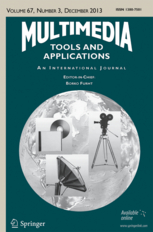S.I. on Artificial Intelligence in Deep Learning Algorithms for Multimedia Analysis
Deep learning has gained a lot of research interest in the Artificial Intelligent (AI) in many applications, such as image understanding, object detection, feature extraction, audio/video processing, image demosaicing and denoising, overhead views in industrial applications. In addition, exploitation of deep learning in the field of data science, particularly in big data analytics focuses on high-level feature extraction and abstraction as data representation based on the hierarchical learning process. Moreover, deep learning is also designed to tackle supervised learning problems for a wide verity of tasks, how to reliably solve unsupervised tasks in a similar degree of success is an important issue to address. Such studies are investigated based on the adoption of parallel computing, i.e., GPUs and CPUs clusters.
Various algorithms are already applied to achieve the desired goals. For instance, convolution neural network has established superior performance on the large-scale image and video classification. The supervised learning (Semi/weakly) methods have expressively enhanced the performance when an only a small amount of annotated data is available. In addition, correlation analysis, transfer learning, multi-tasking have proven their effective contribution in integrating heterogeneous data. Moreover, clustering and sparse techniques are examined in demosaicing and denoising raw data. A large amount of audio, video, and text data being generated by machines that require efficient deep learning algorithms in terms of accuracy and efficiency. Another key aspect is to work on smaller datasets, which focuses on how we can get the gains of unlabelled instances with few ladled samples. Deep agents can play a vital role in the decision system where other deep learning techniques are used to focus on the bridging the data gap between data and the application decision.
At this juncture, several challenges need to be addressed to reduce capability gaps. Indeed, increasing depth and width of audio/video and the emerging phenomenon of big dimensionality of data render the shortfalls of ensemble deep learning. Thus, increasing the number of challenges. Methods and techniques are needed to address the aforementioned constraints in terms of enhancing accuracy and efficiency, reducing the complexity, removal of noise, and to be more specific, novel frameworks are required that focuses on the deep learning aspect of artificial intelligence while keeping the quality within the bounds in a real-time and context aware fashion.
In this special issue, we aim to provide a forum for researchers with an interest in efficiency to examine challenging research questions, showcase the state-of-the-art, and share breakthroughs.
Topics of interest include but are not limited to theoretical or empirical contributions to:
- Compact representation of text and speech data using AI in deep learning
- Fast and/or space efficient algorithms for analysis of audio/video using AI in deep learning
- Information retrieval using AI in deep learning
- Information retrieval algorithms for audio/video through the use of specialized hardware such as GPUs, FPGAs and quantum computers
- Parallel algorithms for AI in deep learning
- Deep Learning Applications in Any Aspects of Perceptual Tasks (e.g., Object/Face Detection and Recognition, Image/Video Understanding, and Audio/Speech Recognition)
- AI in Deep Multimodal Learning
- AI in Deep learning for data indexing and retrieval
- Multi-view and cross-view Deep Learning based visual content analysis
- Mathematical foundations of AI in Deep learning
- Domain adaptation and transfer learning with AI in deep learning
Submission format:
Submitted papers should present original, unpublished work, relevant to one of the topics of the Special Issue. All submitted papers will be evaluated on the basis of relevance, significance of contribution, technical quality, scholarship, and quality of presentation, by at least three independent reviewers. It is the policy of the journal that no submission, or substantially overlapping submission, be published or be under review at another journal or conference at any time during the review process. Submit your manuscript on http://www.springer.com/computer/information+systems+and+applications/journal/11042 and select the “1148: Artificial Intelligence in Deep Learning Algorithms for Multimedia Analysis” special issue manuscript type.
Guest editors
Marco Anisetti
Università Degli Studi Di Milano, Crema, Italy
marco.anisetti@unimi.it
Ernesto Damiani
Department of Electrical and Computer Engineering, Khalifa University, UAE
ernesto.damiani@kustar.ac.ae
Gwanggil Jeon
Incheon National University, Korea
gjeon@inu.ac.kr
Burak Kantarci
School of Electrical Engineering and Computer Science, University of Ottawa, Canada
burak.kantarci@uOttawa.ca



